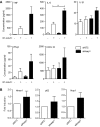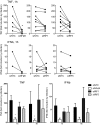Keap1 regulates inflammatory signaling in Mycobacterium avium-infected human macrophages
- PMID: 26195781
- PMCID: PMC4534286
- DOI: 10.1073/pnas.1423449112
Keap1 regulates inflammatory signaling in Mycobacterium avium-infected human macrophages
Abstract
Several mechanisms are involved in controlling intracellular survival of pathogenic mycobacteria in host macrophages, but how these mechanisms are regulated remains poorly understood. We report a role for Kelch-like ECH-associated protein 1 (Keap1), an oxidative stress sensor, in regulating inflammation induced by infection with Mycobacterium avium in human primary macrophages. By using confocal microscopy, we found that Keap1 associated with mycobacterial phagosomes in a time-dependent manner, whereas siRNA-mediated knockdown of Keap1 increased M. avium-induced expression of inflammatory cytokines and type I interferons (IFNs). We show evidence of a mechanism whereby Keap1, as part of an E3 ubiquitin ligase complex with Cul3 and Rbx1, facilitates ubiquitination and degradation of IκB kinase (IKK)-β thus terminating IKK activity. Keap1 knockdown led to increased nuclear translocation of transcription factors NF-κB, IFN regulatory factor (IRF) 1, and IRF5 driving the expression of inflammatory cytokines and IFN-β. Furthermore, knockdown of other members of the Cul3 ubiquitin ligase complex also led to increased cytokine expression, further implicating this ligase complex in the regulation of the IKK family. Finally, increased inflammatory responses in Keap1-silenced cells contributed to decreased intracellular growth of M. avium in primary human macrophages that was reconstituted with inhibitors of IKKβ or TANK-binding kinase 1 (TBK1). Taken together, we propose that Keap1 acts as a negative regulator for the control of inflammatory signaling in M. avium-infected human primary macrophages. Although this might be important to avoid sustained or overwhelming inflammation, our data suggest that a negative consequence could be facilitated growth of pathogens like M. avium inside macrophages.
Keywords: Keap1; Mycobacterium avium; human primary macrophages; infection; inflammation.
Conflict of interest statement
The authors declare no conflict of interest.
Figures











References
-
- Wagner D, Young LS. Nontuberculous mycobacterial infections: A clinical review. Infection. 2004;32(5):257–270. - PubMed
-
- Appelberg R. Pathogenesis of Mycobacterium avium infection: Typical responses to an atypical mycobacterium? Immunol Res. 2006;35(3):179–190. - PubMed
-
- Ernst JD. The immunological life cycle of tuberculosis. Nat Rev Immunol. 2012;12(8):581–591. - PubMed
-
- Jo E-K. Mycobacterial interaction with innate receptors: TLRs, C-type lectins, and NLRs. CurrOpin Infect Dis. 2008;21(3):279–286. - PubMed
Publication types
MeSH terms
Substances
LinkOut - more resources
Full Text Sources
Other Literature Sources
Research Materials
Miscellaneous

